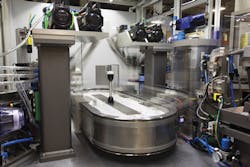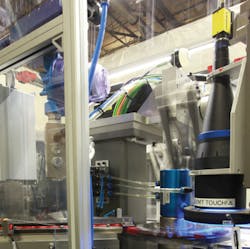Automation assists aerosol actuator assembly
A fully automated system has been developed which transforms the way that consumer aerosol spray actuators used in personal hygiene products are manufactured.
Jeff Walsh and Mathew Newcombe
Over the past 50 years, Computer Numerical Controlled (CNC) machines have revolutionized the way that mechanical components are manufactured. However, until recently, these programmable machines have not been deployed extensively to automate the process of assembling intricate components. Often, the machines which perform such functions are purely mechanical systems custom built to perform one single assembly operation. As such, tooling them to accommodate different variants is challenging, while re-tooling them for new products was next to impossible.
Now, engineers at Transformix (Kingston, ON, Canada;www.transformix.com) have applied numerical control techniques to the world of assembly automation, developing so-called "CNCAssembly" machines which are configurable and multi-purpose - just like CNC machining centers and injection molding presses. The configurability is due to a suite of CNCAssembly "Processing Engines" that can be linked together to assemble and inspect a range of products at high rates with rapid and cost-effective changeovers between production runs.
To support that level of complexity, all axes of assembly motion use programmable servo motors, high-speed solenoid valves, electronic actuators and robotics, while sophisticated sensors such as flow meters, lasers and vision systems are also widely deployed. These determine the location of products in the assembly cycle and ensure that the components from which the final assembly is built-and the final assembly itself-are inspected according to exact manufacturing standards.
Actuator assembly
Traditionally, consumer aerosol spray actuators used in personal hygiene products such as body sprays were built using conventional mechanical methods. But when Transformix presented their vision of a fully configurable and multi-purpose assembly machine to a client in that industry, it gave the company the opportunity to develop and invent their patented Rapid Speed Matching (RSM) technology without which CNCAssembly would not be possible. Out of this project the first CNCAssembly machine was born. Because the new machine is flexible through quick-change tooling and programming, it can accommodate numerous product variants (Figure 1).
The CNCAssembly machine assembles the entire aerosol spray actuator from three components-an insert for atomizing the aerosol medium, an actuator to contain the insert and activate the aerosol valve, and a twist-lock cover.
To do so, a servo-controlled pallet fitted with a set of product-specific tooling is transferred, using the RSM technique, around a large oval servo-track, known as a Transport Engine. At three stations around the track, the components are inspected before being assembled onto the tooling by modular CNCAssembly Processing Engines. A fourth station is used to inspect the final product, after which it is ejected from the tooling. Finally, a fifth inspection station ensures that the product has been effectively unloaded from the system.
At the first of the stations, the actuators enter the machine from a vibratory bowl feeder and are carried down an accumulation track in the correct up/down orientation, but with a random radial orientation. Traditionally, such bowl feeders and tracks would be tooled so that the parts would leave the bowl feeder oriented correctly. However, because the Transformix system uses vision and servo-motors to perform the radial orientation operation at a later stage, the bowl feeders and tracks no longer need to be dedicated to a single product, they can now be more "open" to accommodate wider variety of parts if need be.
Once an actuator leaves the accumulation track of the bowl feeder, it is fed onto a so-called RSM disc - a rotating singulation dial with three semicircular apertures, each of which has two pockets. As two of the parts are sequentially positioned onto the pockets of the RSM disc, vacuum is applied at the side of the pockets to maintain their position on the disc as it is rotated.
To inspect the parts, the RSM disc holding the actuators is revolved under a vision inspection station. Here, each actuator is illuminated with a CCS America (Burlington, MA, USA;www.ccs-grp.com) blue LED diffused backlight and a silhouette image of the actuator captured by a Cognex (Natick, MA, USA; www.cognex.co) In-Sight Micro Vision self-contained vision system that is mounted directly above the component (Figure 2).
At the vision inspection station, the orientation of the plastic actuators is determined. In addition, the actuators are inspected to determine the presence of molding defects such as short shot and flash, to ensure parts with such defects do not enter production. Short shot can happen when molten plastic does not fully occupy a mold cavity, while flash occurs when some molten plastic escapes from a mold cavity during the manufacturing process.
Once the image data of the actuator has been captured by the camera, algorithms from Cognex's In-Sight Explorer software library inspect the parts. A radial edge detection operation on the image determines the presence of flash on the component, while a blob detection operation is performed to locate the edges of the component, from which its radial orientation can be derived.
After the vision system has determined whether parts meet the necessary inspection criteria - and has also determined their orientation - the pass/fail and orientation data is sent from the In-Sight Micro Vision system via an EthernetIP communication protocol to an Allen Bradley (Milwaukee, WI, USA; http://ab.rockwellautomation.com) ControlLogix Programmable Automation Controller (PAC).
The PAC calculates the shortest path that the Processing Engine's pick and place robot needs to take to pick the actuators from the RSM disc and sequentially place them onto the moving pallet. If the part has failed the inspection process, a pick command will not be sent to the robot from the PAC, and the part will not be picked off the RSM disc by the robot. Instead, it continues to rotate on the disc until it reaches a reject station where the vacuum is released and the part falls into a reject bin.
If a part has passed the inspection process, the PAC sends a command to the robot to pick up the component. The servo end-of-arm-tooling on the robot then executes the shortest rotational movement needed to pick up the component, orient it correctly and load it onto the tooling fixtures on the pallet. Once two parts have been loaded onto the pallet, it moves to the second assembly station around the Transport Engine.
Insert inspection
At the second of the assembly stations, a bowl feeder orients the inserts of the actuator assembly, after which the parts are fed from an out feed accumulation track onto pockets on the outside rim of another RSM disc where they are held in place by vacuum. The parts on the RSM disc are then positioned in front of a vision inspection station where a Cognex In-Sight Micro Vision system determines the dimensions of their orifices.
To do so, a blob detection operation from Cognex' In-Sight Explorer software detects a white grouping of pixels in the image that represents the orifice. Next, the centroid of the blob is calculated and a circle find tool used to identify the outer diameter of the orifice. Lastly, the geometry of the orifice is compared with set tolerances to determine whether the part should be accepted or rejected by the system.
If the inserts pass the inspection, the PAC instructs them to be picked off the disc by a servo-controlled RTP (Rotating Tooling Platform) which is another Processing Engine in the suite of modules that make up Transformix's CNCAssembly System. To pick the parts, two tools on the RTP are advanced using linear servo motors until they make contact with the inserts presented by the disc. The vacuum holding the parts on the disc is then released, and the tools on the RTP, now holding the inserts, are retracted. Having picked up the inserts, the RTP rotates to the pallet to press the inserts into the two actuators which are already present (Figure 3). If a part fails inspection, it is retained on the RSM disc and released at a later stage into a reject bin.
Before the pallet moves to the third assembly station where the cover is fitted to the actuator, a test is performed to ensure that there are no blockages in the actuator/insert sub-assembly. To do so, compressed air is passed through the pallet into the base of the two actuator/insert subassemblies. The flow of air is then measured by a pair of Festo flow meters which produces a discrete pass/fail output signal that is sent to the PAC for each part.
Cover mount
Having assembled the actuator and the insert, the pallet then transfers to the third assembly station on the Transport Engine where the cover is inspected and mounted onto the actuator/insert subassembly. Here, the cover undergoes the same vision-based orientation procedure as the actuator, except that the pick-and-place robot of the Processing Engine at the cover station is also used to install the cover on the actuator.
At the cover inspection station, the covers are fed, in random orientations, from the accumulation track of a bowl feeder into an RSM disc which holds them in place in apertures on its outer rim. As the RSM disc rotates, each of the covers move under a vision inspection system that determines the orientation of the part.
To do so, the cover is front lit by a ring light and images of the part are captured by a Cognex In-Sight Micro Vision camera fitted with a telecentric lens. Preprocessing operations in the Cognex In-Sight Explorer software is then used to accentuate the key features on the component, after which a blob detection algorithm determines the radial orientation of the part. Data relating to the key features found in the image enables the camera to calculate the precise angle through which the cover should be rotated by the pick and place robot to enable it to be fitted correctly to the actuator/insert subassembly (Figure 4).
After the cover has been installed on the actuator/insert subassembly by the robot, the finished parts are carried around the Transport Engine to the third of the imaging stations where a backlit image of them is captured by a Cognex 7000 stand alone vision system. A blob detection algorithm enables the bottom of the components to be located, after which edge detection and lines of best fit tools allow the outer features of the parts to be identified. Having done so, the vision system can then determine the height and angularity of the assembly and whether it meets the tolerances demanded by the manufacturer.
Once all the assembly processes and the final inspection have been completed, the pallet moves around the track to a station where the parts are either rejected or accepted. In order for this to occur, the pallet holding the parts is moved in front of one of two chutes where an air blast from air porting in the tooling ejects the parts.
After the assemblies have been unloaded from the pallet, a Cognex Checker with IR (infrared) lighting is used to verify that components have been unloaded from the machine tooling, before it re-enters the system. To do so, the Cognex checker performs a simple pattern match to determine the presence or absence of the tooling itself. If absent, then one or more of the parts has failed to be ejected from the tooling.
Since it was installed at the aerosol spray actuator manufacturer's site, the new machine has been inspecting and assembling actuators flawlessly 24 hours a day, seven days a week. Should the manufacturer now need to update the machine to handle components of a different geometry, the operation can be performed quickly and effectively, due to the programmability of the machine.
Jeff Walsh, VP of Sales and Business Development, and Mathew Newcombe, Vision Systems Specialist, Transformix Engineering, Kingston, ON, Canada (www.transformix.com).
Companies mentioned
Allen Bradley
Milwaukee, WI, USA
http://ab.rockwellautomation.com
CCS America
Burlington, MA; USA
www.ccs-grp.com
Cognex
Natick, MA, USA
www.cognex.com
Transformix
Kingston, ON, Canada
www.transformix.com




